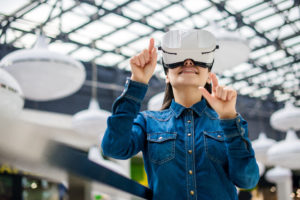The South Pole was exactly as I expected—snowy and barren, apart from the giant research station in front of me. Suddenly, I got a notification in my communication system that there was a strong signal coming from the sky. I looked up and changed the visual display settings of my goggles to find stunning views of the Solar System, all the way past Pluto. My heads-up display told me that I’ve discovered a subatomic particle, called a neutrino, that flies through the fabric of space at nearly the speed of light. I wanted to find the source of this neutrino, so I switched my display to X-ray vision. The signal brightened, and the source was revealed—a massive black hole. I captured as much data as possible so I could report back to the lead scientist on the project. What an exciting afternoon of research!
Okay, I’ve never actually been to the South Pole, but I experienced this event in virtual reality at a conference expo booth for the National Science Foundation. This experience put me in the shoes of an astrophysicist working at the IceCube Neutrino Detection Facility, operated by UW-Madison researchers. As someone who specializes in the life sciences, I had the opportunity to learn more about an area outside my expertise—the fascinating world of particle physics.

Most people think of augmented reality (AR) and virtual reality (VR) in the context of gaming or entertainment. You’ve likely had a casual AR experience if you’ve ever given yourself a flower crown in Snapchat, or hunted for Charmander at your local park with the Pokémon GO app. Yet, as I experienced at a conference several weeks ago, AR and VR can have massive implications for education and training experiences in the sciences. Continue reading “Virtual Reality Is Changing How We Experience Science”
